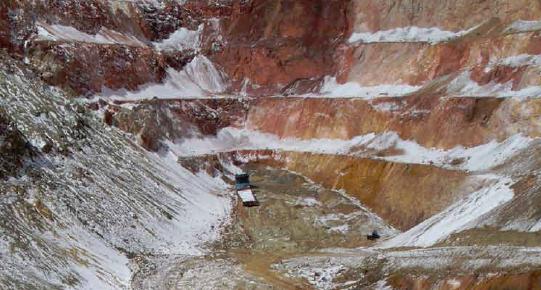
Sage Gold is in transition from an exploration company to a production company. President and CEO Nigel Lees explains the significance of the change to April Terreri.
Toronto-based Sage Gold Inc. is still a new company, having been established just six years ago. For the first five years of operation, the company was focused primarily on exploration in Canada and the US. But just within the past six months the company strategy shifted because of the opportunity to acquire compliant gold assets in the market at reasonable prices. “This strategy will assist us in developing and financing ongoing exploration projects as well as new mining opportunities,” says Nigel Lees, president and CEO.
A gold exploration company up until just a few months ago, Sage Gold recently entered into a series of options to acquire properties with compliant resources. “Most of our exploration had been focused on the Beardmore-Geraldton Gold Camp (BGGC) near Thunder Bay, Ontario,” reports Lees. “This is a small and historically good gold camp that, in our view, had been underdeveloped and underexplored. We have had a fair amount of success in exploration here, including the discovery and development of a compliant resource in the Lynx Deposit, which is a polymetallic deposit containing copper, gold and silver. It has not been fully drilled out or explored, and there is the potential for a larger deposit.”
The surface contains about 500,000 metric tons (tonnes)of good-grade ore with about 2 percent copper. The underground resource has 1.9 million tonnes with 1.4 percent copper. “This mine is amenable to open-pit mining on the surface and is a deposit that can be expanded greatly through further drilling,” explains Lees. There is also 135,000 acres of exploration properties in the BGGC on which Sage Gold has already done extensive exploration, both in terms of geochemistry and geophysics.
But since the strategy change, the company is now eyeing production at two gold-producing properties, each with permits. “These two projects really demonstrate our shift from exploration to production,” notes Lees. Through an option deal, Sage Gold will have a 60 percent interest in the Clavos gold mine near Timmins. “This is a major world-class gold camp that has historically produced about 85 million ounces of gold.” The agreement is to earn 60 percent interest in the property over a three-year period. Sage Gold will invest C$3 million on the property in order to earn that interest. There has been C$72 million already spent on infrastructure at Clavos, with C$42 million on the underground. “We believe this is an excellent deal. We have a great partner, and we’re confident we will not only be able to expand the resource but also utilize the processing capacity available in the area so that our capital costs will be relatively low to put this property into production.” Lees adds that a great benefit of the Timmins area is the availability of many processing mills with excess capacity, meaning that Sage Gold will not have to invest in building a cost-intensive mill.
The other property is the Borealis gold mine in Nevada, about two and a half hours from Reno. It had been mined previously by Echo Bay, who ceased mining operations in the late 1980s. “Echo Bay had mined the surface oxides, which had produced about 600,000 ounces of gold before they closed it down. Because gold prices had been dropping steadily back then, it was no longer economical to mine the oxides. Now, with gold prices about three times the price as when they closed the mine, it’s economically feasible. We have an option agreement here with Gryphon Gold to acquire a 50 percent interest in this property. We will make a $400,000 investment in shares of Gryphon, and after a feasibility study and before June 2011 we’ll invest $9 million in the property or in the Borealis mine, whichever we decide to do at that time.” Gryphon Gold is currently drilling the oxide cap. It has a resource of about 2.5 million ounces of both oxide and sulphide. There is a new resource estimate and bankable study under way, and the oxide portion of the Borealis resource is scheduled for production in late 2011.
“The shift from exploration to production is very significant for our company, especially because of the current environment,” Lees says. “People are looking for hard assets, cash flow, near-term cash flow or existing cash flow. This is opposed to investments in companies that are exploring with a very long timeframe before they can begin to go into production. So within a year or two these two properties potentially will be in production, which will lead to a cash flow for us. So this is very much in line with what we think is an appropriate strategy in the kind of economic environment we’re in today, especially with current favorable gold prices.”
Going forward, Lees anticipates high valuation in these production projects. “Through a positive cash flow, we’ll be able to finance our own projects in the future. You see, one of the negatives relative to an exploration company is you constantly have to go to the marketplace to raise money in order to do more exploration. So by becoming more self-sustained, we can use our cash flow to help explorations, make other acquisitions of other properties, or further develop the exploration projects we’ve already invested in. Our current strategy will make our company far more self-sustaining than it is currently.”
Sage Gold operates with a very lean business plan. “We have few employees, with a strong staff of technical and financial professionals,” Lees explains. “We use a lot of outside contractors for exploration development, drilling and mining development. We don’t ever plan to have a large staff because of the perceived and real cyclical nature of commodities in general. We don’t want to have too much fixed overhead, so by using outside consultants we can operate a more flexible company.”
Lees notes that Sage Gold is fortunate to have the Board of Directors that it has. “The board is composed of individuals who have extensive experience in the mining industry. With this kind of strength, we’re very comfortable with the risk factors we might face. We’ve positioned ourselves to be in well-known and well-tried gold camps in areas that have historically been very productive and in communities that are favorable toward mining, which is very important to us.” www.sagegoldinc.com













